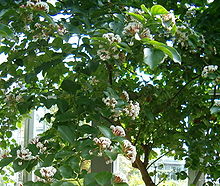Carissa spinarum
| Carissa spinarum | |
|---|---|

| |
| Scientific classification | |
| Kingdom: | Plantae |
| Clade: | Tracheophytes |
| Clade: | Angiosperms |
| Clade: | Eudicots |
| Clade: | Asterids |
| Order: | Gentianales |
| Family: | Apocynaceae |
| Genus: | Carissa |
| Species: | C. spinarum
|
| Binomial name | |
| Carissa spinarum | |
| Synonyms | |
|
Numerous, see text | |
Carissa spinarum, the conkerberry or bush plum, is a large

It grows as a multi-stemmed shrub, 0.5 to 3 metres in height. The leaves are glossy green, opposite, narrow ovate to lanceolate and 1–5 cm in length. The branches bear thorns of 1–3 cm length. White, star-shaped flowers ~1 cm across are followed by ovate green berries, 1–2 cm in length, which turn black or dark purple when ripe.
Ecology


Carissa spinarum is most often found in
Conkerberries are edible, but only when fully ripe; they have a sweet flavour, but the milky sap of this plant – and its unripe fruit – is poisonous, as typical for the Apocynaceae. They are a popular
Carissa spinarum is frequently a weed in grazing land in northern Australia, choking out grasses, reducing the ability of livestock to feed, interfering with stock handling and providing a refuge for vermin. The plant is capable of reproducing rapidly by
Parts of the plant are used
Fruit extracts from the plant have shown
Synonyms
Well known for its fruit to locals and quite variable across its wide range and diverse habitat types, the conkerberry has been described time and again by
But in fact, C. spinarum was already named by
The following list gives the names under which the conkerberry has been placed in Carissa. Apart from that, it has also been assigned, under various names, to Antura and Arduina (both now synonymized with Carissa), as well as


- Carissa abyssinica R.Br.
- Carissa africana A.DC.
- Carissa axillaris Roxb.
- Carissa brownii F.Muell.
- Carissa campenonii (Drake) Palacky
- Carissa candolleana Jaub. & Spach
- Carissa carandas var. congesta (Wight) Bedd.
- Carissa carandas var. paucinervia (A.DC.) Bedd.
- Carissa cochinchinensis Pierre ex Pit.
- Carissa comorensis (Pichon) Markgr.
- Carissa congesta Wight
- Carissa coriacea Wall.
- Carissa cornifolia Jaub. & Spach
- Carissa dalzellii Bedd.
- Carissa densiflora Baker
- Carissa diffusa Roxb.
- Carissa dulcis Schumach. & Thonn.
- Carissa edulis (Forssk.) Vahl
- C. edulis var. septentrionalis is probably a valid species, Carissa septentrionalis
- Carissa hirsuta Roth
- Carissa horrida Pichon
- Carissa inermis Vahl
- Carissa lanceolata R.Br.
- Carissa laxiflora Benth.
- Carissa macrophylla Wall.
- Carissa madagascariensis Thouars ex Poir.
- Carissa obovata Markgr.
- Carissa oleoides Markgr.
- Carissa ovata R.Br.
- Carissa paucinervia A.DC.
- Carissa pilosa Schinz
- Carissa pubescens A.DC.
- Carissa revoluta Scott-Elliot
- Carissa richardiana Jaub. & Spach
- Carissa scabra R.Br.
- Carissa sechellensis Baker
- Carissa suavissima Bedd. ex Hook.f.
- Carissa tomentosa A.Rich.
- Carissa villosa Roxb.
- Carissa xylopicron Thouars
- Carissa yunnanensis Tsiang & P.T.Li
Footnotes
- ^ Plummer, J. (2020). "Carissa spinarum". IUCN Red List of Threatened Species. 2020: e.T68112038A68112072. Retrieved 31 October 2022.
- ^ "World Checklist of Selected Plant Families: Royal Botanic Gardens, Kew". apps.kew.org. Retrieved 7 August 2017.
- ^ Bussmann, R. W., et al. (2006). Plant use of the Maasai of Sekenani Valley, Maasai Mara, Kenya. J Ethnobiol Ethnomed 2 22.
- ^ Shri, K.S.; Sharma, Y.P.; Pankaj, S.; Pratima, V.; Randhawa, S.S. (2018). "Wild edible fruits of Himachal Pradesh state centre on climate change & UNEP-GEF-MoEFCC project report" (PDF).
- PMID 24093795.
- ^ J. H. Maiden (1889). The useful native plants of Australia : Including Tasmania. Turner and Henderson, Sydney.
- ^ "Plants of Myanmar Checklist". botany.si.edu. Retrieved 7 August 2017.
- ^ Tropicos.org [2009]
References
- Tropicos.org [2009]: Synonyms of Carissa spinarum L.. Retrieved 2009-NOV-26.
External links
- Alice Springs Town Council
- Bush plum dreaming
- Dressler, S.; Schmidt, M. & Zizka, G. (2014). "Carissa spinarum". African plants – a Photo Guide. Frankfurt/Main: Forschungsinstitut Senckenberg.

